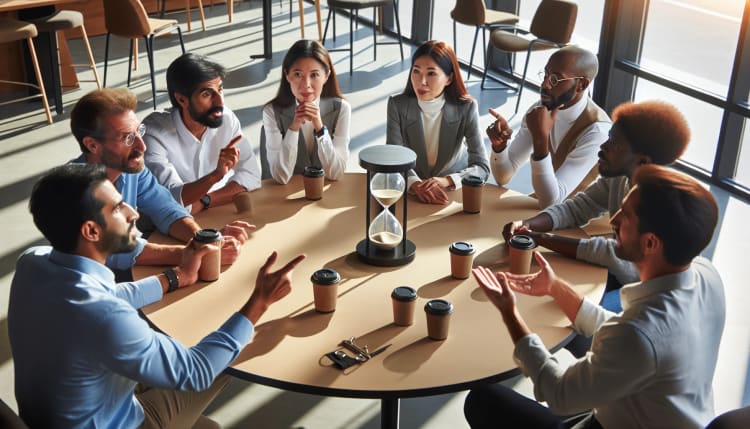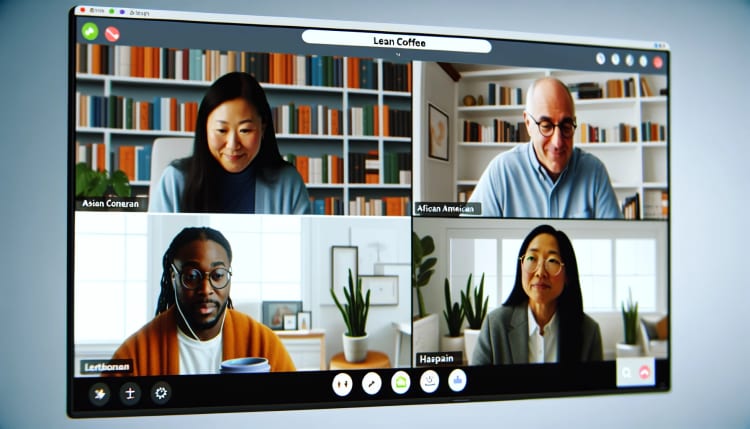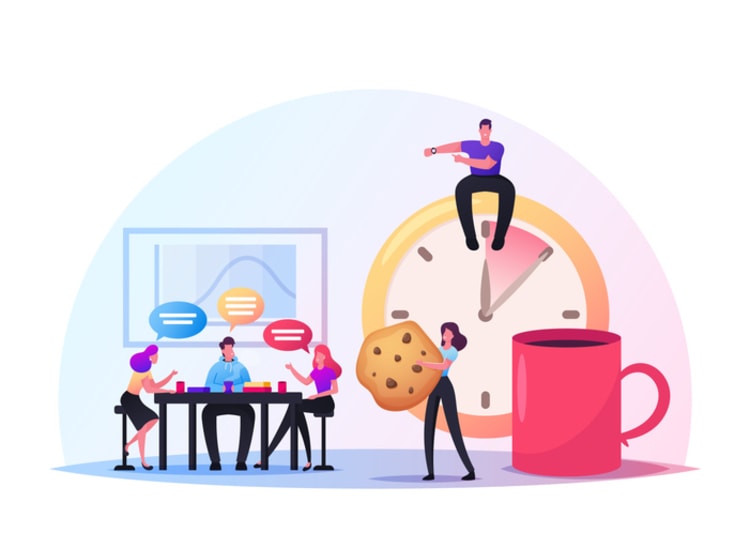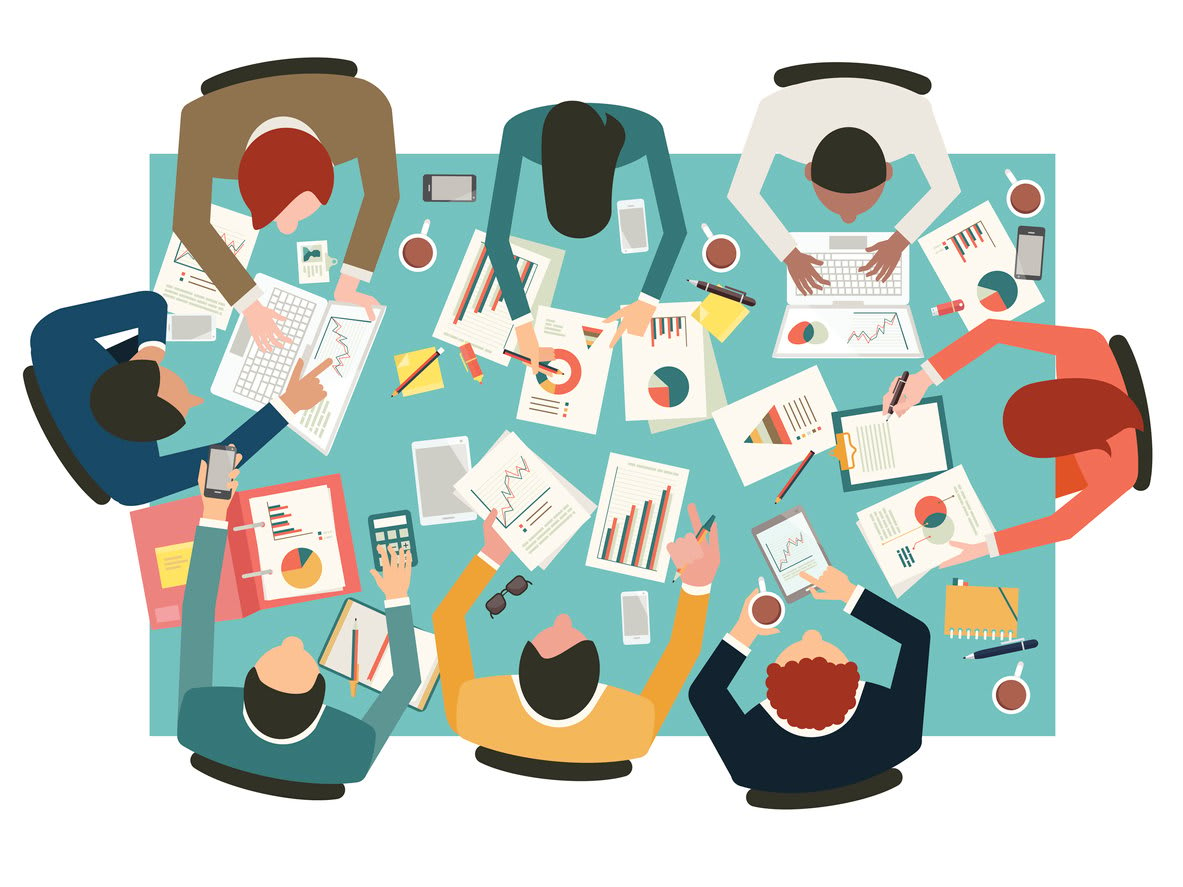Are you tired of unproductive meetings that seem to go on forever, with no clear agenda and no tangible outcomes? It’s time for a change! Meet Lean Coffee, a meeting format that empowers participants to drive the conversation, resulting in focused and productive discussions. This blog post will guide you through the ins and outs of Lean Coffee, providing you with a roadmap to transform your team discussions into dynamic, powerful sessions.
Through this journey, we will explore the origins and principles of Lean Coffee, learn how to organize a successful session, adapt the format for virtual meetings, and customize it to suit your team’s needs. Say goodbye to dull meetings and hello to a world of engaging, collaborative conversations that deliver real results.
Key takeaways
- Lean Coffee is an efficient meeting format that encourages learning, collaboration and self-organization.
- Organizing a successful Lean Coffee session requires direction, gathering topics from participants & facilitating timeboxed discussions.
- Real world applications of Lean Coffee include team retrospectives & networking/conferences for more meaningful connections.
Understanding the Lean Coffee meeting format

Lean Coffee is a meeting format that combines structure with flexibility, allowing participants to democratically generate the agenda and decide which topics to discuss. This approach keeps the conversation focused and productive, as everyone is invested in the topics chosen. Lean Coffee is often used for sprint retrospectives, conferences, and even replacing regular corporate meetings. The format works best with smaller groups of up to 10 participants, ensuring focused and productive discussions.
The idea behind Lean Coffee is simple yet powerful - participants gather, propose topics for discussion, vote on them, and then engage in timeboxed conversations on the highest-ranked topics. The process is adaptable, making it suitable for various settings and objectives. From coffee shops to virtual meetings, Lean Coffee has proven to be an effective approach to fostering engaging, inclusive, and productive discussions.
Origins of Lean Coffee
Lean Coffee was born in 2009 in Seattle, thanks to the creative minds of Jim Benson and Jeremy Lightsmith. Both were Lean coaches who sought to create a group that didn’t require steering committees or a whole new cumbersome organization. They wanted a space where people could come together to lean coffee start their journey in:
- Learn
- Create
- Share ideas
- Collaborate
All of this would be done free from rigid agendas and bureaucratic constraints.
Their innovative idea quickly gained traction, and Lean Coffee spread across the globe as a popular meeting format. Today, it is used by agile teams, corporate groups, and conference attendees alike, providing a democratic, engaging, and efficient way to discuss lean techniques and share ideas.
Key principles of Lean Coffee
At the core of Lean Coffee’s success lies a set of key principles that drive effective and inclusive conversations. First, the agenda is created during the meeting, giving attendees the opportunity to propose topics that matter to them and reflect their priorities. Second, a voting system is used to prioritize the topics, ensuring that the most relevant and pressing issues are addressed first.
The core principles of Lean Coffee are:
- Openness and transparency, where everyone is encouraged to share their ideas, thoughts, and opinions on the topics being discussed.
- Self-organization, where participants take ownership of the meeting and decide which topics to discuss and in what order.
- Active participation, where everyone’s voice is heard and valued, creating an engaging, democratic, and inclusive environment. These principles make Lean Coffee a powerful meeting format that fosters collaboration, drives continuous improvement, and keeps conversations focused and productive.
How to organize a successful Lean Coffee session

While the process of setting up a Lean Coffee session is uncomplicated, it does ask for a bit of groundwork and direction to guarantee a successful outcome. The process begins with gathering topics from participants, followed by prioritizing the topics through voting, and finally, facilitating timeboxed discussions. For a seamless Lean Coffee session, it’s important to foster an environment of openness and inclusivity, encouraging everyone to share their thoughts and ideas freely.
Tailoring the Lean Coffee template to fit your team’s needs and preferences is key to achieving the intended results. Adjusting time limits, voting rules, and incorporating action items and follow-up steps can help tailor the format to your specific goals and objectives. We will further elaborate on each of these steps in the subsequent sections, offering a thorough guide on how to organize a successful Lean Coffee session.
Gathering topics from participants
To kick off a Lean Coffee session, participants should be encouraged to suggest topics for discussion. This can be achieved by creating a relaxed and non-judgmental atmosphere, allowing everyone to feel at ease while proposing their ideas. Topics can be written on sticky notes and placed on a whiteboard or entered into a virtual Kanban board, depending on the meeting format.
It’s important to note that the initial brainstorming phase should have a time limit to ensure efficiency and focus. Once all the topics have been gathered, the next step is to prioritize them through voting, as described in the following subsection.
Prioritizing topics through voting
Once all topics are collected, the next step is to rank them through a voting process. This democratic approach ensures that the most relevant and pressing issues are addressed first, keeping the conversation focused and engaging. Each participant can be given a set number of votes (usually around three) to distribute among the topics as they see fit.
The voting process should also have a time limit, typically around three minutes, to maintain the meeting’s momentum. Once the voting is complete, the topics with the most votes are prioritized for discussion, and the Lean Coffee session can move on to the next phase - facilitating timeboxed discussions.
Facilitating timeboxed discussions

Timeboxing is an essential element of Lean Coffee sessions, as it keeps discussions focused and efficient. The initial timebox for each topic is usually set at around 4 to 5 minutes, after which the group decides whether to extend the conversation or move on to the next topic. These time limits are flexible and can be adjusted based on the group’s preferences and the complexity of the topics being discussed.
The facilitator has a significant role in directing the conversation, making sure the discussion remains focused and everyone gets a chance to contribute. By adhering to the timeboxed format and using a meeting facilitation technique, Lean Coffee sessions can deliver:
- Productive meetings
- Engaging meetings
- Efficient meetings
- Meetings that address the most pertinent issues
Adapting Lean Coffee for virtual meetings

The growth of remote work has rendered virtual meetings an integral part of contemporary business operations. Adapting the Lean Coffee format for virtual meetings is not only possible but also highly beneficial, as it offers an engaging and efficient way to collaborate with remote team members. By using the right tools and fostering an environment of active participation, virtual Lean Coffee sessions can be just as effective as their in-person counterparts.
In the upcoming sections, we will further discuss:
- The selection of appropriate tools for virtual Lean Coffee sessions
- How to guarantee active participation from all attendees
- Aiding you to utilize the power of Lean Coffee in your remote meetings.
Choosing the right tools with Kumospace
Choosing the right set of tools is pivotal for hosting engaging and productive virtual meetings. Kumospace, for example, offers an immersive 2D environment, digital whiteboards, interactive displays, screen sharing, and video/audio conferencing, making it an excellent platform for Lean Coffee sessions.
Other online tools that can be used to host virtual Lean Coffee sessions include:
- Lean Coffee Table
- Zoom
- Google Meet
- Microsoft Teams
These platforms facilitate collaboration, agenda creation, and tracking of action items, ensuring your virtual meetings are productive and engaging.
Ensuring active participation
Cultivating an environment that encourages active participation from all attendees is key to the success of virtual Lean Coffee sessions. As the facilitator, it is crucial to create an inclusive atmosphere, allowing everyone to feel comfortable sharing their thoughts and ideas.
To encourage active participation, directly ask for input, and make sure everyone has an opportunity to contribute to the discussion. The democratic nature of Lean Coffee, coupled with a structured yet agenda-less meeting format, ensures that everyone’s voice is heard, leading to more engaging and productive virtual meetings.
Customizing the Lean Coffee template for your team

Like any meeting format, tailoring the Lean Coffee template to fit your team’s distinct needs and preferences is necessary. Adjusting time limits, voting rules, and incorporating action items and follow-up steps can help tailor the format to your specific goals and objectives, ensuring that your Lean Coffee sessions are as effective and productive as possible.
In the sections to follow, we will examine different ways to customize the Lean Coffee template, equipping you with the tools and insights needed to fully leverage this potent meeting format.
Adjusting time limits and voting rules
To accommodate your team’s dynamics and objectives, you may need to adjust the time limits and voting rules in your Lean Coffee sessions. For example, you can set the initial timebox for each topic based on your team’s preferences and the complexity of the topics being discussed. Additionally, you can experiment with different voting rules, such as dot voting or using thumbs-up icons, to prioritize topics and allocate discussion time accordingly.
By tweaking these aspects of the Lean Coffee format, you can create a productive meeting structure that best aligns with your team’s needs, fostering productive and engaging discussions.
Incorporating action items and follow-up
One of the key strengths of Lean Coffee is its ability to generate actionable insights and drive continuous improvement. To make the most of this potential, it’s essential to incorporate action items and follow-up steps into your Lean Coffee sessions. To effectively run a lean coffee, ensure that these elements are well-integrated into the process.
During the discussion, identify any action items that arise and assign them to the appropriate team members. Ensure that these tasks are visible and accessible, such as on a whiteboard or shared document. Incorporating a clear meeting agenda can help streamline this process. At the end of the session, review the action items and make sure they are clear and achievable.
Following up with team members to track progress and ensure tasks are completed is crucial for maintaining accountability and driving improvement.
Real-world applications of Lean Coffee

Lean Coffee, being a flexible meeting format, finds applications in diverse real-world settings, ranging from team retrospectives to networking events and conferences. Its democratic, engaging, and efficient nature makes it an excellent choice for fostering productive conversations and driving continuous improvement in lean coffee meetings, also known as lean coffees.
In the upcoming sections, we will examine explicit applications of Lean Coffee, showcasing the format’s potential to revolutionize team discussions and yield substantial results in varied contexts.
Team retrospectives
Using Lean Coffee for team retrospectives can promote effective communication, continuous improvement, and enhanced collaboration. The format’s structured yet flexible nature allows team members to identify areas for improvement, share insights, and develop actionable steps to enhance performance in the next sprint. By implementing a lean coffee retrospective, teams can effectively reflect on their progress and make necessary adjustments for future success.
By incorporating Lean Coffee into your team retrospectives, you can:
- Foster an environment of open and honest dialogue
- Drive continuous improvement
- Ensure that your team remains agile and adaptable in the face of ever-changing challenges.
Networking and conferences
Lean Coffee can also be implemented in networking events and conferences as a lean coffee event, providing a collaborative and structured format for discussions. Attendees have the opportunity to decide the agenda and share their thoughts and opinions on the topics, leading to engaging and interactive conversations that maximize the value of the event. By choosing to run lean coffee, participants can experience a more efficient and focused discussion.
By employing Lean Coffee in networking events and conferences, you can:
- Create an inclusive and engaging environment
- Encourage active participation
- Foster meaningful connections among attendees
- Make the most of the time and resources invested in these events.
Summary
In conclusion, Lean Coffee is a powerful meeting format that combines flexibility with structure, empowering participants to drive the conversation and achieve productive, focused discussions. By understanding its origins and principles, organizing successful sessions, adapting the format for virtual meetings, and customizing the template to suit your team’s needs, you can unlock the full potential of Lean Coffee and transform your team discussions.
Whether you’re hosting team retrospectives, networking events, or conferences, Lean Coffee offers a dynamic and engaging approach to collaboration and communication. Embrace the power of Lean Coffee, and discover a world of focused, efficient, and inclusive meetings that drive continuous improvement and deliver real results.
Frequently asked questions
Lean Coffee is an informal meeting without a pre-set agenda, allowing participants to vote on suggested topics and guide the conversation. It starts with participants gathering and creating the agenda, then diving into the discussion.
To make Lean Coffee, ask participants to suggest topics, vote on those topics, break into groups and discuss, then have each group review key themes and takeaways. Set up personal Kanban boards to track progress, and facilitate discussion between teams as they work their way through the chosen topics.
Lean coffee best practices include keeping the conversation focused, ensuring the final answer has no artifacts, connecting with readers with a casual tone and writing a clear conclusion in the first sentence.
Yes, Lean Coffee can be adapted for virtual meetings by utilizing the capabilities of tools like Kumospace, Zoom, or Google Meet and facilitating active participation.
Customize the Lean Coffee template by adjusting time limits, voting rules, and adding action items and follow-up steps to meet your team's unique needs and preferences.





